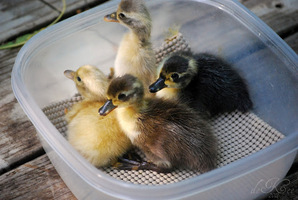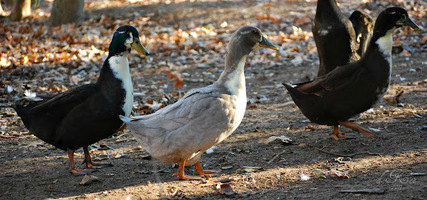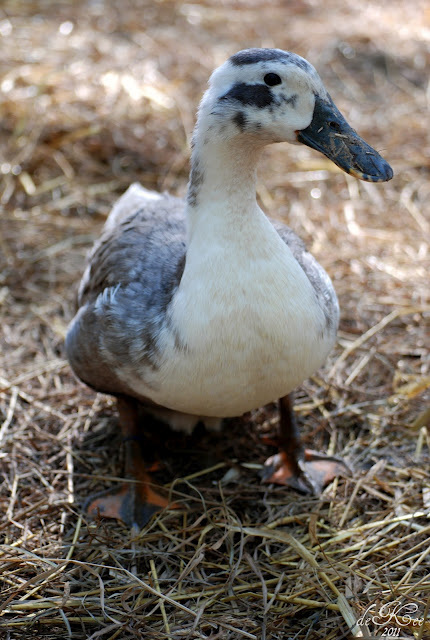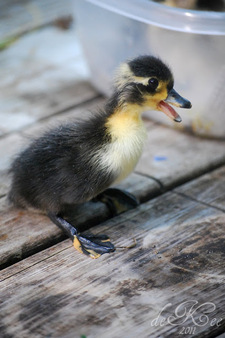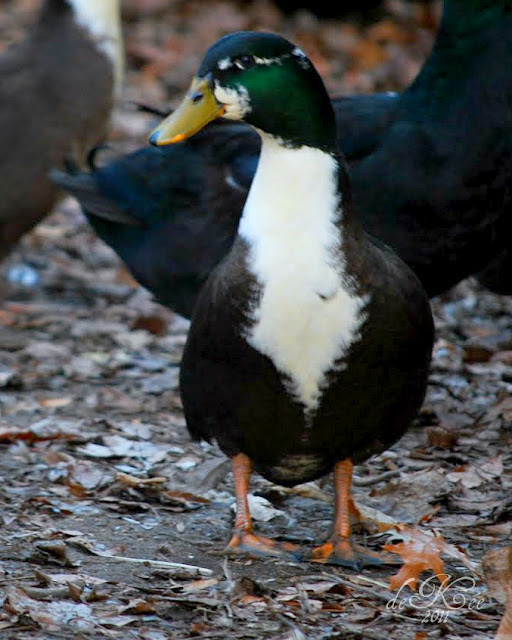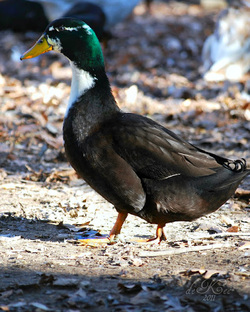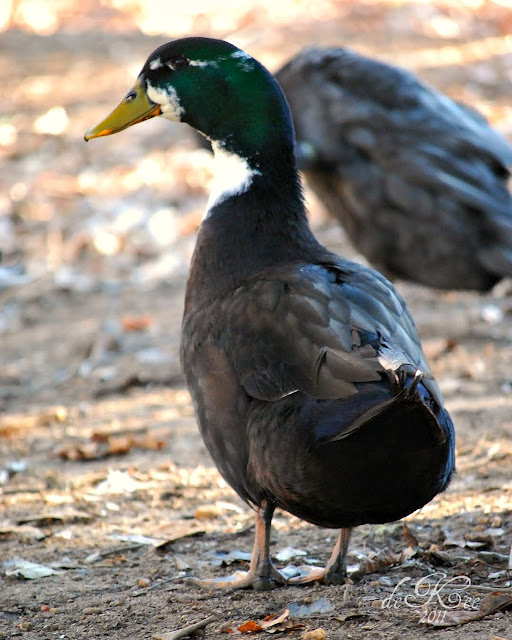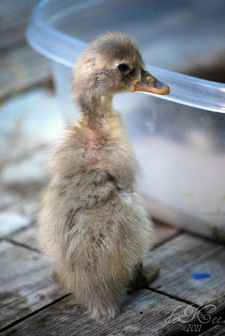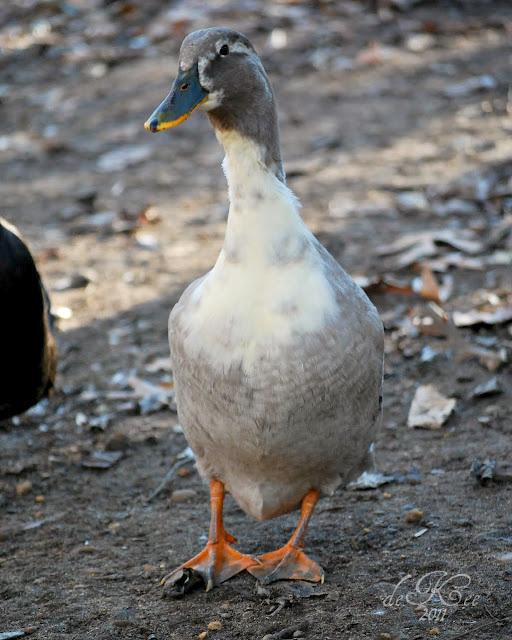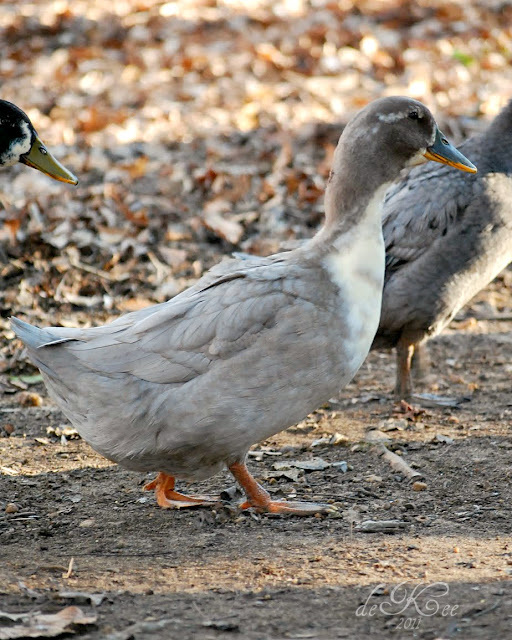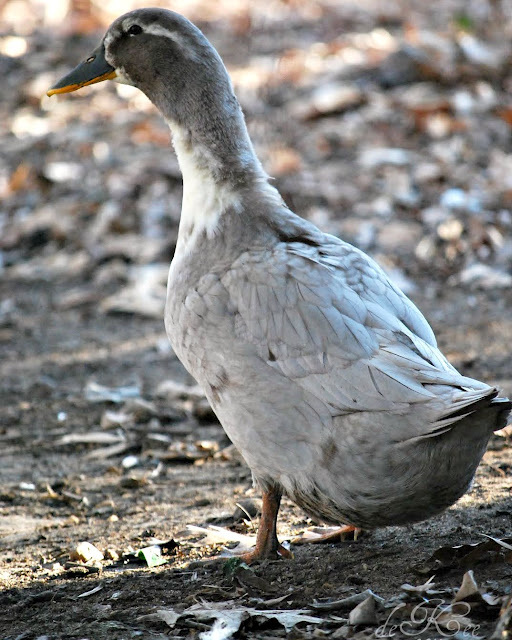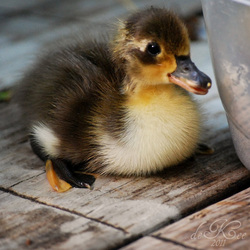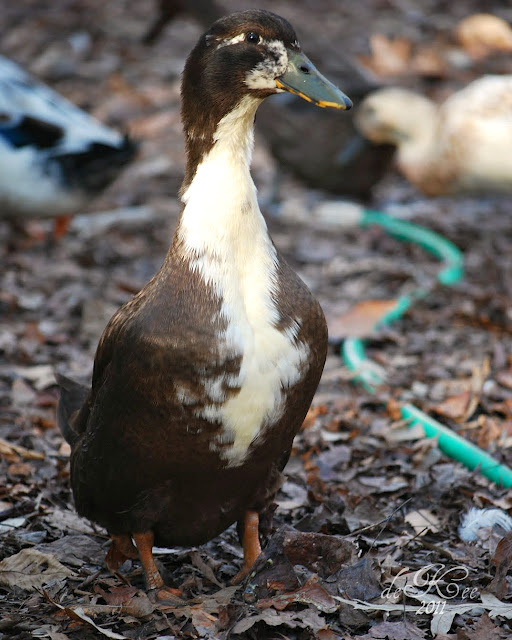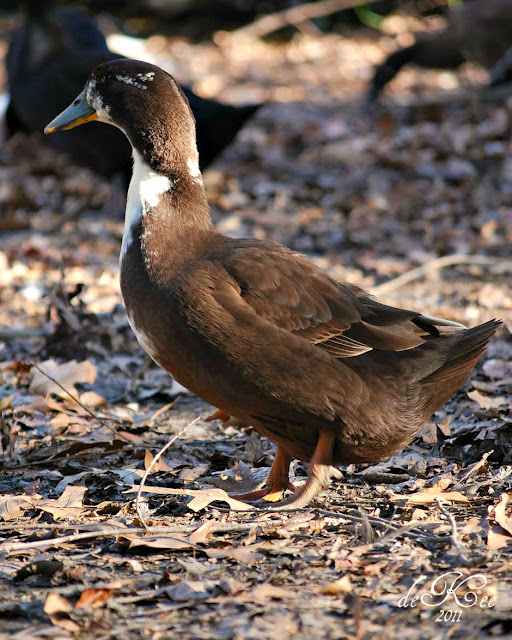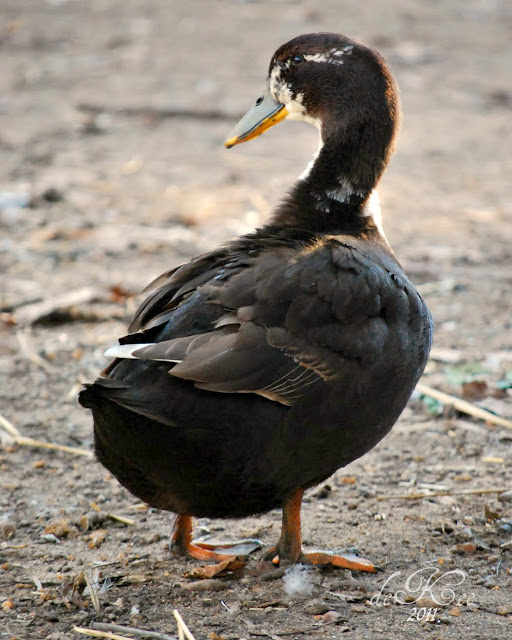Welsh Harlequin x Blue Ancona Cross
Silver Phase Welsh Harlequin drake (Duck Dogers) over Blue Ancona duck (Miss Spot)
In the summer of 2011 I had only a single pair of Holderread Welsh Harlequin ducks: Duck Dogers and Miss Blush. The plan was to keep all the female offspring from these two so that I could increase my flock - I kept 4 and sold the rest. When Blush went broody and set a nest for me, I moved my lone Ancona girl, Spot, into the breeding run to keep Duck Dogers company. The 3 were so much happier than the 2 that I left Spot in the breeding run for the remainder of the season.
Since Spot and Blush's eggs look just alike, if I wanted to hatch Welsh Harlequin I had to set them both in the incubator. So, after carefully marking their eggs when I collected them each day, I discovered that it's very easy to tell which babies are what breed as soon as they hatch. And Duck Dogers was giving me an 85% hatch rate with Blush and Spot... plus... Blush was throwing mostly girls (I only got 1 drake from her the entire season!)
That July I hatched a batch of Spot's eggs that turned out 3 babies with colors I hadn't produced before: one lilac, one chocolate, and one black with multicolored legs and feet, white bibs and white eye stripes. I don't purposefully breed mixes because you don't know what the result will be - but they were adorable! I blogged about them here soon after they were hatched.
A Brief Primer on Color Genetics:
Feather Color Characterization
|
Chocolate:
Blue: Lilac: Lavender: (aka self-blue) |
Dark Brown
Slate Grey Blue Grey-Brown Pale Blue-Grey |
Black, of course, is dominate to all other colors, then brown/choc, then blue. Chocolate, along with a single blue dilution becomes lilac, and with a double dose of blue it becomes lavender. Lilac is a dilution of chocolate and blue; it's darker than lavender with a subtle tawny cast. |
This difference between Li and Lav are important because two lilac ducks will never breed true due to the incompletely dominant blue gene. Lilac will throw chocolates, lilacs, and lavenders. However, two lavender ducks will breed true and produce only lavender offspring. For the best economy of scale, mating Blue x Blue or Blue x Lavender will give you both Blue and Lavender babies (typically about 50% of each variety).
*Their bibbed gene is more or less independent of color and just prevents pigmentation in the chest feathers, resulting in a white "bib." It's dominant so it will "express" itself regardless of the number of bibbed genes present (there's at least one from the Ancona).
*Their bibbed gene is more or less independent of color and just prevents pigmentation in the chest feathers, resulting in a white "bib." It's dominant so it will "express" itself regardless of the number of bibbed genes present (there's at least one from the Ancona).
The ducklings from this mating were sex-linked, all chocolates and lilacs from this pair will be female while black is male.
(Chocolate/Brown dilution from the Welsh Harlequin drake). All of the males would be carriers of the brown dilution gene which they can pass along to their offspring. A chocolate female would donate one brown dilution gene to her male offsping, and none to her female offspring.
How this Little Trio Matured:
Sexing ducklings without vent sexing: (Thanks to Wifzilla at BYC)
Voice Sexing: The quack noise usually associated with ducks ONLY comes from the females. Males make a very monotone, deep, raspy peep noise even though both males and females start out sounding the same. As the duck matures, the voice changes.
Females can start quacking as soon as 2 weeks after hatching, but it is more likely going to take 4-6 weeks before you hear the females make a quack noise. As it was rather humorously described by another BYC member, the female quack can also sound more like the cross between "a cough and a fart" instead of an outright quack. The key is tonal range and volume. Girls will make a wide variety of noises and will get louder with time; if the duck peeps happily along and then makes a weird loud noise, it is usually a girl.
Boys voices will change from typical duckling peeping noises to a more monotone peeping. Eventually, usually by 8 weeks, they will be very monotone and much quieter than females only making a raspy noise. In the case of muscovy ducks, males will huff-huff.
Go to this site to hear sound files of the different noises made by male and female ducks.
http://www.majesticwaterfowl.org/artquacks.htm
In this short video, the grunting "whoopie cushion" noises are coming from the young female khaki campbell mix duck (rich brown colored). The peeping is from the younger male rouen.
http://www.youtube.com/watch?v=v5yORHKQsyw
Plumage Sexing: Many ducks have different feathering on males and females. Mallards are a prime example with males having shiny green heads, a white neck ring, brown chest, etc... while the females are a more uniform dull brown. This is fine for telling adults apart, but not very helpful for ducklings. Many ducklings go through a developmental phase where they all look like females. It isn't until they are 3 months or more that you will begin to see signs of adult feathering.
One sure sign is the "drake feather". On male ducks, one or two of their tail feathers will curl up while the feathers on a female's tail will remain flat. The drake feather may not appear for 2-3 months. If the duck is molting, it is also possible to not see a drake feather until new feathers grow in.
Other sex-linked matings: (thanks to Dances with Ducks at BYC)
With certain parents it is also possible to tell the sex of the ducklings by the color of their fluff. These are called sex-linked matings. The drake needs to express the brown dilution and be mated to hens that are genetically black or grey. It doesn't work in reverse (chocolate hens to black drakes for instance). The offspring of sex-linked pairings will have males that are black or near black and brown or lighter in females.
To get sex-linked Harlequin ducklings:
You can mate a Gold Harlequin drake and a Silver Harlequin hen and the drakelets will be silver and the ducklets will be gold. Silver phase ducklings are yellow with a grey blush on their head and tail. Gold phase ducklings are yellow with a bit of brown blush on the head and tail.
To get sex-linked Campbell ducklings (these with be phenotypically Campbells but carry one recessive Harlequin gene):
If you have a Khaki Campbell male you can mate it with a Dark Campbell female and get Khaki ducklets and Dark drakelets.
Or you can mate a Gold Harlequin drake with a Dark Campbell female and get the same results as with a Khaki Campbell drake.
Or you can mate a Khaki Campbell male with a Silver Harlequin and the same results.
These drakes can be used in sex-linked matings:
Khaki Campbell
Gold Harlequin
Penciled Runner
Chocolate Runner
Chocolate Magpie
Chocolate Anacona
Chocolate Muscovy
These hens can be used in sex-linked matings:
Silver Harlequin
Dark Campbell
Black Runner
Grey Runner
Black Magpie
Black Ancona
Black Cayuga
Black Swedish
Silver Appleyard
Grey Rouen
Black Muscovy
Voice Sexing: The quack noise usually associated with ducks ONLY comes from the females. Males make a very monotone, deep, raspy peep noise even though both males and females start out sounding the same. As the duck matures, the voice changes.
Females can start quacking as soon as 2 weeks after hatching, but it is more likely going to take 4-6 weeks before you hear the females make a quack noise. As it was rather humorously described by another BYC member, the female quack can also sound more like the cross between "a cough and a fart" instead of an outright quack. The key is tonal range and volume. Girls will make a wide variety of noises and will get louder with time; if the duck peeps happily along and then makes a weird loud noise, it is usually a girl.
Boys voices will change from typical duckling peeping noises to a more monotone peeping. Eventually, usually by 8 weeks, they will be very monotone and much quieter than females only making a raspy noise. In the case of muscovy ducks, males will huff-huff.
Go to this site to hear sound files of the different noises made by male and female ducks.
http://www.majesticwaterfowl.org/artquacks.htm
In this short video, the grunting "whoopie cushion" noises are coming from the young female khaki campbell mix duck (rich brown colored). The peeping is from the younger male rouen.
http://www.youtube.com/watch?v=v5yORHKQsyw
Plumage Sexing: Many ducks have different feathering on males and females. Mallards are a prime example with males having shiny green heads, a white neck ring, brown chest, etc... while the females are a more uniform dull brown. This is fine for telling adults apart, but not very helpful for ducklings. Many ducklings go through a developmental phase where they all look like females. It isn't until they are 3 months or more that you will begin to see signs of adult feathering.
One sure sign is the "drake feather". On male ducks, one or two of their tail feathers will curl up while the feathers on a female's tail will remain flat. The drake feather may not appear for 2-3 months. If the duck is molting, it is also possible to not see a drake feather until new feathers grow in.
Other sex-linked matings: (thanks to Dances with Ducks at BYC)
With certain parents it is also possible to tell the sex of the ducklings by the color of their fluff. These are called sex-linked matings. The drake needs to express the brown dilution and be mated to hens that are genetically black or grey. It doesn't work in reverse (chocolate hens to black drakes for instance). The offspring of sex-linked pairings will have males that are black or near black and brown or lighter in females.
To get sex-linked Harlequin ducklings:
You can mate a Gold Harlequin drake and a Silver Harlequin hen and the drakelets will be silver and the ducklets will be gold. Silver phase ducklings are yellow with a grey blush on their head and tail. Gold phase ducklings are yellow with a bit of brown blush on the head and tail.
To get sex-linked Campbell ducklings (these with be phenotypically Campbells but carry one recessive Harlequin gene):
If you have a Khaki Campbell male you can mate it with a Dark Campbell female and get Khaki ducklets and Dark drakelets.
Or you can mate a Gold Harlequin drake with a Dark Campbell female and get the same results as with a Khaki Campbell drake.
Or you can mate a Khaki Campbell male with a Silver Harlequin and the same results.
These drakes can be used in sex-linked matings:
Khaki Campbell
Gold Harlequin
Penciled Runner
Chocolate Runner
Chocolate Magpie
Chocolate Anacona
Chocolate Muscovy
These hens can be used in sex-linked matings:
Silver Harlequin
Dark Campbell
Black Runner
Grey Runner
Black Magpie
Black Ancona
Black Cayuga
Black Swedish
Silver Appleyard
Grey Rouen
Black Muscovy

